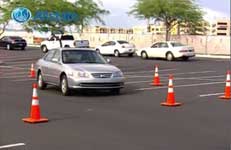How to Drive a Car – Reflexive Driving Skills
No Teen is Really a Safe Driver
As you learn to drive watch the news any evening and you’ll quickly realize that driving a car is dangerous for everyone. Any ‘typical’ outing in a car can change in an instant. And when that happens, there’s no time to think or weigh your options! That’s when reflexive driving skills need to take over and experts agree they take at least 3 years to develop. So no matter how smart or coordinated or reliable 16 or 17 year-olds are – they are never really safe drivers. Just knowing how to drive a car is not enough, practice and experience is also needed.
Teens can know the rules and obey them, but they still don’t have the reflexive driving skills they need to “take over” when they get into trouble. Reflexive driving skills take years of practice – not weeks or months.
Practice is the only way to obtain experience as you learn to drive. It’s the only way new drivers can develop reflexive driving skills, so schedule your driving lessons and stick to the schedule as well as you can. If you miss a driving lesson, schedule a make-up lesson right away. Use the log to keep track of your time and the skills you’re developing.
Reflexive Skills
My daughter, Emily plays the piano. Many years ago, when her lessons began, she learned the basics – how to identify notes and 
Now, when she learns to play a piece, she starts by reading the music, note by note, and finding each note on the keyboard. She memorizes how to play the right-hand first. Then she learns the left hand. She practices them separately for a long time.
Finally, she puts her hands together and labors through the piece. She makes a lot of mistakes but continues to practice until eventually her fingers know what to do. Then the magic happens! They find the keys on their own. She starts to play, and she finishes. In between her fingers find their marks – without her even realizing what they’re doing! That’s reflexive. When your body or brain knows what to do without you even having to think about it. And that comes from a lot of practice and experience. There is simply no shortcut.
Reflexive Driving Skills
Similarly – excellent reflexive driving skills take years of practice too. They are what helps you swerve safely around the crate that falls off the truck in front of you – without going into the ditch or oncoming traffic.
Teens don’t have the maturity or experience to acquire these skills so they are automatically at risk every time they drive.
So – what can parents do to keep their teens safer?
You can get informed and understand the risks – then take advantage of every lesson, product and opportunity that reduces those risks. You can’t make it safe but you can make it safer.
Be thoughtful every time your teen asks for the keys or asks to ride with another teen driver. Ask a lot of questions. Don’t automatically say ‘yes’ and understand the difference between purposeful and recreational driving.




